Urban Agriculture Impacts on the Environment of Awka, Anambra State, Southeastern Nigeria
| Received 31 Dec, 2022 |
Accepted 02 Mar, 2023 |
Published 31 Mar, 2023 |
Background and Objective: Economic growth and migration from rural regions fuel urbanization and its spread brings with it a slew of issues, including food insecurity, poverty and the exclusion of some socioeconomic groups from urban social services. Urban agriculture is the raising, processing, food distribution and other essentials through intensive planting and rearing of animals in and around urban areas. This work focused on the impacts of urban agriculture on the environment of Awka, Anambra State, Southeastern Nigeria and it portrayed agriculture as a developmental tool that expands the economic base of the city through the production, processing, packaging and marketing of consumable goods. Materials and Methods: The sample for the study was chosen using a multi-stage sampling process. Data acquired from the study were evaluated using simple descriptive statistics and Spearman’s Correlation Coefficient. To represent data from the field survey, descriptive statistical techniques such as frequency distribution tables, percentages and histograms were used. Results: The findings showed that urban agriculture makes a significant contribution to the well-being of some city people by providing revenue, employment for a large population, food security and poverty reduction. Conclusion: The urban agriculture should be considered in a broader context, as a lucrative, commercial activity that may create high earnings and give jobs, not merely for the poor’s survival.
| Copyright © 2023 Okafor and Mgbenwelu. This is an open-access article distributed under the Creative Commons Attribution License, which permits unrestricted use, distribution, and reproduction in any medium, provided the original work is properly cited. |
INTRODUCTION
Economic growth and migration from rural regions fuel urbanization and its spread brings with it a slew of issues, including food insecurity, poverty and the exclusion of some socioeconomic groups from urban social services1.
Contemporary urbanization is related to a number of demographic, social and economic challenges2. As a reaction to these issues, supporters of urban agriculture have commended the sector’s potential contribution to food security and poverty reduction3.
Urban agriculture is a prevalent activity all around the world. It is a reality in Nigeria, as well as a response to crises and a coping method in many circumstances. Urban agriculture is a practice that is prevalent in Nigerian cities such as Lagos, Ibadan, Kano, Awka, Enugu and Abuja. It is one of the solutions that improve food security, income generation, job possibilities and local economic growth for the country’s urban people4.
Urban agriculture is a component of the urban ecological system and can help to green the city by safeguarding the environment, reducing the quantity of food waste that needs to be transported out of the city, lowering the city’s ecological footprint and adding to the city’s greening5. Urban agriculture has a wide range of advantages6. It can provide a variety of environmental benefits, such as enhanced garbage recycling, as well as extra health benefits, such as improved physical and psychological health as a result of increased physical activity7.
Smallholder and traditional farmers cultivate the majority of Nigeria’s land, which results in low yields due to unsophisticated agricultural techniques. Small farmers have numerous challenges, including limited access to modern farm inputs and loans, poor infrastructure, forty-three insufficient market access and land and environmental deterioration8. In response to the country’s diminishing agricultural performance, administrations have implemented a slew of policies and programs over the years aimed at restoring agriculture’s prominence in the economy. However, due to a number of chronic obstacles impeding the sector’s performance and no meaningful progress has been made9.
It is critical that proper policy, law and support be made available in the city in order to maximize beneficial impact and decrease health hazards related to urban agriculture. These favourable effects can be measured and judged economically. Potential effects of dirty irrigation water, pesticide use, soil nutrient loss and malaria are among the main health problems linked with urban agriculture10.
The exposed farmers and consumers would be considered in the economic evaluation, wastewater irrigation of crops under suitable agronomic and waste management procedures could produce improved yields by providing more water and nutrients11. Furthermore, urban agriculture encourages employment and income generation12. It does, however, have certain negative environmental consequences.
This work focused on the impacts of urban agriculture on the environment of Awka and it hopes to portray agriculture as a developmental tool that expands the economic base of the city through the production, processing, packaging and marketing of consumable goods.
MATERIALS AND METHODS
Location of the study: Awka is located within latitudes 6°10" and 6°15" N and longitudes 7°14" and 7°84" E in Awka South Local Government Area of Anambra State, Nigeria. It is the capital city of Anambra State and it is bordered by Amansea to the North, Nawfia to the South, Isiagu to the East and Okpuno to the West. The west-east federal highway links Awka to Lagos, Benin City, Asaba, Onitsha and Enugu. The city is located about 6.436×10–2 km East of Lagos in the centre of the densely populated Igbo heartland in South-Eastern Nigeria. The majority of the territory is underlain by a thick series of Paleocene shale and sandstones. Eocene fossils can also be found, these strata are covered by a rich layer of sand and clay with lignite seams. In Anambra State, Quaternary sediments prevail. The impervious clay shale beneath Awka causes water logging in the soil during the rainy season. Ferruginous and hydromorphic soils are the two main soil types observed in the research region.
Sample procedure: From November 10th to 13th, 2021, a preliminary field survey on the effects of urban agriculture on the environment in Awka, Anambra State, Southeastern Nigeria was conducted. The survey assisted the researcher in becoming familiar with the research field. During the survey, the researcher observed the following:
• |
Various wards and their boundaries |
• |
Types of agricultural activities |
• |
People involved in urban agriculture |
• |
The types of fertilizers/manure used on the farms |
• |
Impact of urban agriculture on the environment |
• |
Constraints of urban agriculture |
As part of the data collection process, a field survey was conducted. The purpose of the survey was to look into the effects of urban agriculture on the environment in the study area. The researcher observed that manure from the poultry was spread on farmlands (Plate 1) before the planting of crops to enrich the soil that is already losing its nutrients, deforestation for the cultivation of plants also took place in the study area and urban agricultural produce was sold in the markets promoting food security. The area is prone to flooding and soil erosion as a result of deforestation. In addition, wastewater from a fish pond is discharged into the environment without being treated via a conduit (Plate 2).
Research design: The study concentrated on the effects of urban agriculture on the environment in Awka, Anambra State, in Southeastern Nigeria. As a result, the research design is a survey to collect data and information about the effects of urban agriculture on the environment in the study area. The research design includes the use of a questionnaire and an oral interview. The study was preceded by a visit to the study region in order to acquire important information such as the types of urban agricultural practices, urban agriculture impacts and urban agriculture limits.
Primary and secondary data sources were used to compile the data for this investigation. Field observation, questionnaires and personal interviews were the key sources of data. The purpose of the survey was to learn more about the environmental implications of urban agriculture, as well as the restrictions and types of urban agricultural practices.
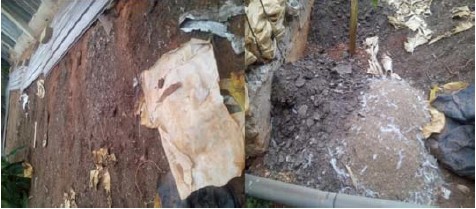
|
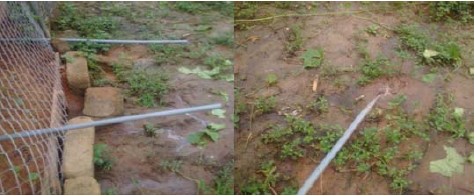
|
The researcher also conducted personal interviews with respondents. Textbooks, research projects, magazines, journal articles, conference/seminar papers, the internet and other research records were used to obtain secondary data from publications and reports.
Data sampling (The universe, sampling frame and size): According to the information gathered by the researcher, there are thirty-three communities in the study region. The sample for the study was chosen using a multi-stage sampling process. The study area was divided into three quarters: Udoka Housing Estate, Umukwa and Umuike, which represented high-, middle- and low-income neighborhood, respectively to give the researchers the opportunity to look into urban agriculture involvement among all income groups in the study region. The initial (main) sample units were created as a result of this. The second stage (secondary) sample unit was formed by selecting a 1km2 region from each of the quarters. A simple random sample procedure was used to select twenty respondents from each of these places. As a result, the study used a sample size of sixty respondents who practiced urban agriculture. Before sending out the questionnaire, age, marital status and degree of education were given priority.
Statistical analysis: For a more specific understanding, data acquired from the study were evaluated using simple descriptive statistics and Spearman’s Correlation Coefficient, named after its originator Charles Spearman. To represent data from the field survey, descriptive statistical techniques such as frequency distribution tables, percentages and histograms were used.
Spearman, the coefficient of correlation is commonly represented as rho (p) or rs. It assesses the strength and direction of a two-variable linear relationship. The r always has a value between +1 and -1. Kerton and Sinclair13 suggested that the following values for correlation r be interpreted as follows to interpret its value: Exactly -1, A perfect negative linear relationship. -0.70, A strong negative linear relationship. -0.50, A moderate negative relationship. -0.30, A weak negative linear relationship. 0, No linear relationship. +0.30, A weak positive linear relationship. +0.50, A moderate positive relationship. +0.70, A strong positive linear relationship and Exactly +1, A perfect positive linear relationship.
Decision rule: The decision rule states that “If the confidence level p, is less than 0.05, you should reject the null hypothesis in favor of the alternative”. “If p is more than 0.05, you should not reject the null hypothesis”. All of the analyses were conducted using SPSS version 20 (a computer-based statistical program known as Statistical Package for Social Sciences).
RESULTS AND DISCUSSION
Total 53 respondents take part in this study, out of which 21 were males and 32 were females. This demonstrated that women dominated urban agriculture in the area. These findings corroborated by Kremer and DeLiberty14, found that women make up the majority of urban farmers around the world.
The age distribution of respondents was shown in Fig. 1. Majority of persons were between the ages of 36-50 years.
The majority of the respondents (75.47%) were married, 18.87% were single and 5.66% were widowed. This suggested that the majority of the area’s urban farmers were married. The majority of the urban farmers in the area were married. Their engagement in urban farming would assure their families’ food security. The 47.17% of respondents had received primary education, 33.96% had received secondary school, 11.32% had received tertiary education and 7.55% had received no formal education as shown in Fig. 2. This indicated that the majority of the responders were uneducated. Formal education has long been acknowledged to have a good impact on farmers’ adoption of new technologies15.
Out of 53 respondents, 54.72% were unemployed, whereas 45.28% were employed. This was because persons who have completed tertiary education have more work options than those who have completed primary and secondary education. According to the numbers shown in Fig. 2, the percentage of people with tertiary education was the lowest, implying that unemployment will be high.

|
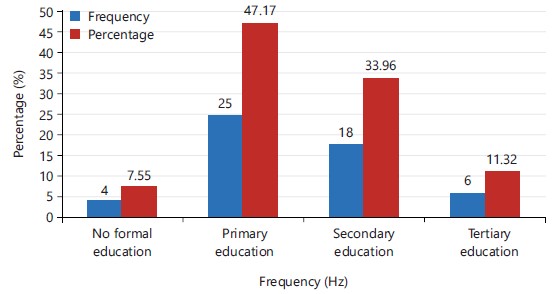
|

|
Figure 3 revealed that (33.96%) of the respondents had the urban farming experience of about 20 years. This showed that most of the respondents were well-experienced in urban farming.
The majority of respondents (49.06%) had a high level of revenue from farming, followed by 35.84% with a moderate level of income and 15.09% with a low level of income. The high level of income from farming (including poultry and farming) which implies that the majority earning higher annual income are better than others because they have access to needed inputs and extension services.
The 41.51% of respondents used urban agriculture as a source of supplementary income, 33.96 % stated that they were food secure and 24.53% stated that they were fully employed. This demonstrated that urban agriculture provides three possibilities to the participants, as well as increasing employment prospects, food security, money production and poverty alleviation.
The principal occupation of the respondents was shown in Fig. 4. The bulk of the respondents (39.62%) were civil servants, 32.08% were full-time farmers, 15.09% were traders and 13.21% were involved in other industries, according to the findings. This research supported the findings of Larsen and Gilliland16, found that most farming operations in urban areas were done on a part-time basis by persons who had other jobs. This participation in urban agriculture was intended to supplement household food income.
The various reasons why some respondents engage in urban agriculture was shown in Fig. 5. The 15.09% of respondents answered that they engage in urban agriculture to supplement their meals, 20.75% stated that the food they purchase in the market is too expensive and the majority (22.64%) stated that they engage in urban agriculture because of poverty. According to Maxwell17, certain populations were invulnerable to food insecurity, poverty and poor social status in most countries of the world, these families turn to urban gardening to lessen their vulnerability to food security.
The 43.4% of respondents had an annual income of between $101,000 and $150,000, followed by those with an annual income of over $150,000 (26.42%) and 16.98% had an annual income of between $51,000 and $100,000. This demonstrated that the area’s urban farmers were low-income earners. Because income level has a positive association with the level of adoption, their low economic position may limit their ability to obtain capital-intensive technology18 as shown in Fig. 6.
The challenges of urban agriculture were shown in Fig. 7. Farm productivity, household income and food security might all suffer as a result of the lack of these key institutional services combined with the high cost of labour. These findings corroborated by Zezza and Tascotti19, who highlighted limited access to land, a lack of support services (finance, extension and input supply), crop theft on the farm and a high cost of labor as some of the barriers to the development of urban agriculture in Nigeria.
The percentage distribution of respondents’ answers on the impact of urban agriculture on the environment of Awka revealed that erosion was the most significant negative environmental impact of urban agriculture as shown in Fig. 8.
The percentage distribution of respondents’ answers on the positive impact of urban agriculture on the environment of Awka revealed that waste reduction is the most significant positive environmental impact of urban agriculture was shown in Fig. 9.
Hypotheses testing
Restatement of the hypothesis:
H0 : |
Urban agriculture has no significant effect on the environment of Awka |
H1 : |
Urban agriculture has a significant effect on the environment of Awka |
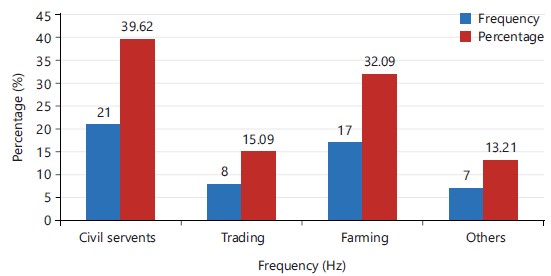
|
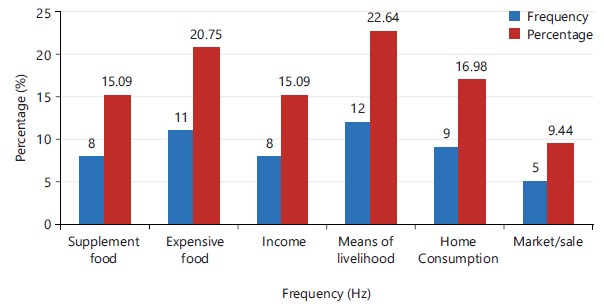
|
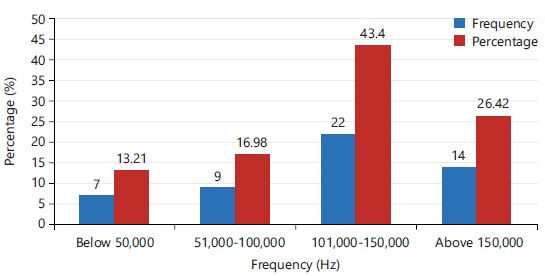
|
Testing the hypothesis: Spearman’s Correlation Coefficient was the statistical instrument employed to test the hypothesis. The hypothesis testing sought to discover if there was a link between urban agriculture and environmental damage. The independent variable is urban agriculture, while the dependent variables are adverse environmental impacts. The total number of respondents was 53 and each respondent’s replies were associated with his or her perception of Awka’s environmental impact. The result of the correlation analyses was shown in Table 1.
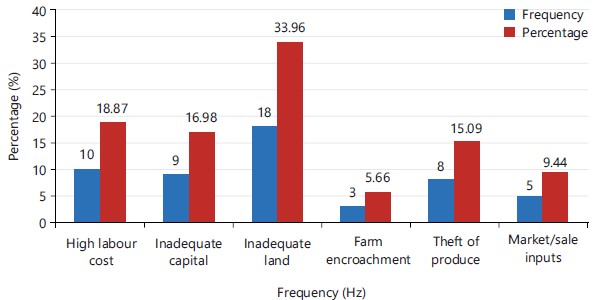
|
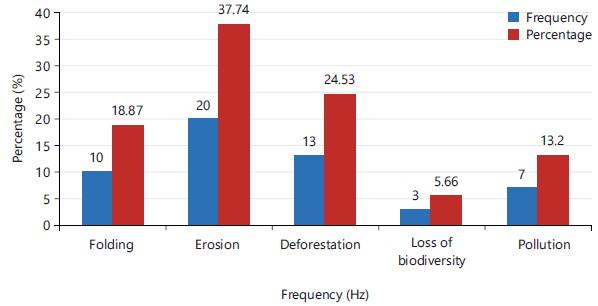
|
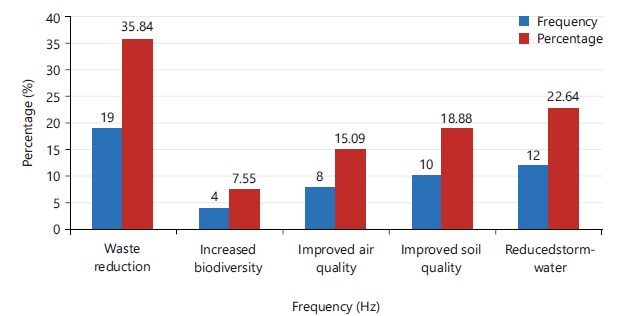
|
In this case, the correlation coefficient was 0.684. This demonstrated a moderately good relationship between urban agriculture and Awka's environmental impact. While, 0.000 is the p-value. The null hypothesis was rejected that urban agriculture has no substantial impact on Awka’s environment since the
| Table 1: | Spearman’s correlation coefficient for the impact of urban agriculture on the environment of Awka | |||
| Urban agriculture | Environmental impact | |||
| Spearman’s rho | Urban agriculture | Correlation coefficient | 1 | 0.684** |
| Sig. (2-tailed) | . | 0 | ||
| N | 53 | 53 | ||
--------------------------------------------------------------------------------------------------------------------------------------------------- |
||||
| Environmental impact | Correlation coefficient | 0.684** | 1 | |
| Sig. (2-tailed) | 0 | . | ||
| N | 53 | 53 | ||
| **Correlation is significant at the 0.01 level (2-tailed), Source: SPSS Version 20 Computer Output, the results were interpreted below: Coefficient = 0.684 and p = 0.000 | ||||
CONCLUSION
In Awka, urban agriculture protects biodiversity, promotes waste education and reduces the energy required to produce and transport food. It’s also about health and nutrition, as well as ensuring that low-income residents have access to good food. In Awka, urban agriculture has been demonstrated to have negative consequences that must be addressed in order for sustainability to be included in the practice. In the interests of the environment and public health, farmers who practice it should be trained to do so. As a result, urban agriculture should be considered an important part of the city’s economic, employment and food systems.
SIGNIFICANCE STATEMENT
The purpose of the study was to determine the urban agriculture impacts on the environment of Awka, Anambra State, Southeastern Nigeria. The results of this work will have implications for policy makers, agriculturists, environmentalists and academics as they seek to identify emergent areas of research. However, since there was no comprehensive study on the urban agriculture impacts on the environment of the study area, this research work was framed in a larger context to cover the gap in the literature, with a clear discussion of the scholarly significance and contributions of the research findings by the use of quality data control measures which will serve as scholarly/scientific lessons for an international audience.
ACKNOWLEDGMENT
Our profound appreciation goes to the almighty God for his protection, goodness and mercy throughout the period of the study.
REFERENCES
- Alaimo, K., E. Packnett, R.A. Miles and D.J. Kruger, 2008. Fruit and vegetable intake among urban community gardeners. J. Nutr. Educ. Behav., 40: 94-101.
- Bonacich, E. and J. Alimahomed-Wilson, 2011. Confronting racism, capitalism, and ecological degradation: Urban farming and the struggle for social justice in black Los Angeles. Souls, 13: 213-226.
- Bradley, K. and R.E. Galt, 2014. Practicing food justice at dig deep farms & produce, east bay area, California: Self-determination as a guiding value and intersections with foodie logics. Local Environ., 19: 172-186.
- Brown, C. and S. Miller, 2008. The impacts of local markets: A review of research on farmers markets and Community Supported Agriculture (CSA). Am. J. Agric. Econ., 90: 1296-1302.
- Campbell, M.C. and D.A. Salus, 2003. Community and conservation land trusts as unlikely partners? The case of Troy Gardens, Madison, Wisconsin. Land Use Policy, 20: 169-180.
- Corrigan, M.P., 2011. Growing what you eat: Developing community gardens in Baltimore, Maryland. Appl. Geogr., 31: 1232-1241.
- Crush, J., A. Hovorka and D. Tevera, 2011. Food security in Southern African cities: The place of urban agriculture. Prog. Dev. Stud., 11: 285-305.
- Ellis, F. and J. Sumberg, 1998. Food production, urban areas and policy responses. World Dev., 26: 213-225.
- Glover, T.D., K.J. Shinew and D.C. Parry, 2005. Association, sociability, and civic culture: The democratic effect of community gardening. Leisure Sci., 27: 75-92.
- Guyatt, G.H., A.D. Oxman, H.J. Schünemann, P. Tugwell and A. Knottnerus, 2011. GRADE guidelines: A new series of articles in the journal of clinical epidemiology. J. Clin. Epidemiol., 64: 380-382.
- Holland, L., 2004. Diversity and connections in community gardens: A contribution to local sustainability. Local Environ., 9: 285-305.
- Jarosz, L., 2008. The city in the country: Growing alternative food networks in Metropolitan Areas. J. Rural Stud., 24: 231-244.
- Kerton, S. and A.J. Sinclair, 2010. Buying local organic food: A pathway to transformative learning. Agric. Hum. Values, 27: 401-413.
- Kremer, P. and T.L. DeLiberty, 2011. Local food practices and growing potential: Mapping the case of Philadelphia. Appl. Geogr., 31: 1252-1261.
- Landis, B., T.E. Smith, M. Lairson, K. Mckay, H. Nelson and J. O'Briant, 2010. Community-supported agriculture in the research triangle region of North Carolina: Demographics and effects of membership on household food supply and diet. J. Hunger Environ. Nutr., 5: 70-84.
- Larsen, K. and J. Gilliland, 2009. A farmers' market in a food desert: Evaluating impacts on the price and availability of healthy food Health Place, 15: 1158-1162.
- Maxwell, D., C. Levin and J. Csete, 1998. Does urban agriculture help prevent malnutrition? Evidence from Kampala. Food Policy, 23: 411-424.
- van der Knaap, L.M., F.L. Leeuw, S. Bogaerts and L.T.J. Nijssen, 2008. Combining campbell standards and the realist evaluation approach: The best of two worlds? Am. J. Eval., 29: 48-57.
- Zezza, A. and L. Tasciotti, 2010. Urban agriculture, poverty and food security: Empirical evidence from a sample of developing countries. Food Policy, 35: 265-273.
How to Cite this paper?
APA-7 Style
Okafor,
O.C., Mgbenwelu,
P.O. (2023). Urban Agriculture Impacts on the Environment of Awka, Anambra State, Southeastern Nigeria. Trends in Agricultural Sciences, 2(1), 44-53. https://doi.org/10.17311/tas.2023.44.53
ACS Style
Okafor,
O.C.; Mgbenwelu,
P.O. Urban Agriculture Impacts on the Environment of Awka, Anambra State, Southeastern Nigeria. Trends Agric. Sci 2023, 2, 44-53. https://doi.org/10.17311/tas.2023.44.53
AMA Style
Okafor
OC, Mgbenwelu
PO. Urban Agriculture Impacts on the Environment of Awka, Anambra State, Southeastern Nigeria. Trends in Agricultural Sciences. 2023; 2(1): 44-53. https://doi.org/10.17311/tas.2023.44.53
Chicago/Turabian Style
Okafor, Odera, Chukwumaijem, and Pamela Ogochukwu Mgbenwelu.
2023. "Urban Agriculture Impacts on the Environment of Awka, Anambra State, Southeastern Nigeria" Trends in Agricultural Sciences 2, no. 1: 44-53. https://doi.org/10.17311/tas.2023.44.53

This work is licensed under a Creative Commons Attribution 4.0 International License.




